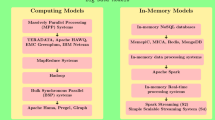Abstract
CodiP2P and DisCoP are two peer-to-peer (P2P) computing overlays aimed at sharing computing resources (CPU, Memory, etc.) to execute parallel applications. Their component nodes are basically PC’s and a wide range of computer servers, desktops or laptops. This paper joins these two platforms into a new one, DisCoP2P, to combine the features from both overlays. CodiP2P is highly scalable, and DisCoP has an efficient searching mechanism and the ability to classify computing resources. The new platform takes advantage of these features and uses them to offer new facilities to schedule and execute parallel applications efficiently. This is accomplished at null cost because the platform is made up of nodes that share resources for free. This research field can also be classified in desktop computing. The success of this platform depends greatly on the added overhead. This overhead is produced mainly in searching for resources and system administration. The obtained results in a preliminary prototype, although not sufficiently conclusive, demonstrate the applicability of DisCoP2P in the real world, i.e. Internet.







Similar content being viewed by others
References
Aberer K (2001) P-grid: a self-organizing access structure for p2p information systems. In: Proceedings of the 9th international conference on cooperative information systems, CooplS ’01. Springer-Verlag, London, pp 179–194
AL-Dmour NA, Saraireh MS (2011) Parcop with new capabilities and efficient scheduling policies. Leonardo J Sci 18:11
Auvinen A, Vapa M, Weber M, Kotilainen N, Vuori J (2006) Chedar: peer-to-peer middleware. In: IPDPS, IEEE
Caminero AC, Robles-Gomez A, Ros S, Hernandez R, Tobarra L (2013) P2p-based resource discovery in dynamic grids allowing multi-attribute and range queries. Parallel Comput 39(10):615–637
Castellà D, Barri I, Rius J, Giné F, Solsona F, Guirado F (2008) Codip2p: a peer-to-peer architecture for sharing computing resources. In: International symposium on distributed computing and artificial intelligence, DCAI 2008, vol. 50. Springer, Berlin, pp 293–303
Castellà D, Blanco H, Giné F, Solsona F (2010) Combining Hilbert SFC and Bruijn graphs for searching computing markets in a P2P system. In: Proceedings of the 16th international Euro-Par conference on Parallel processing, EuroPar’10. Springer-Verlag, Berlin, pp 471–483
Castella D, Gine F, Solsona F, Lluis Lérida J (2013) Analyzing locality over a P2P computing architecture. J Netw Comput Appl 36(6):1610–1619. doi:10.1016/j.jnca.2012.12.032
Esfahanian A, Hakimi L (1985) Fault-tolerant routing in DeBruijn communication networks. IEEE Trans Comput 34:777–788
Gupta R, Sekhri V, Somani A (2006) CompuP2P: an architecture for internet computing using Peer-to-Peer networks. IEEE Trans Parallel Distrib Syst 17(11):1306–1320
Jose L, de Souza S, Foltran D (2010) Towards a peer-to-peer framework for parallel and distributed computing. Symposium on Computer Architecture and High Performance Computing, pp 127–134
Khan S, Gani A, Sreekandath M (2011) The routing performance of logarithmic-hop structured p2p overlay. In: 2011 IEEE conference on open systems (ICOS), pp 202–207
Kotilainen N, Vapa M, Weber M, Toyryla J, Vuori J (2005) P2pdisco—java distributed computing for workstations using chedar peer-to-peer middleware. In: Proceedings of the 19th IEEE international parallel and distributed processing, symposium (IPDPS’05)
Kwok S, Chan K (2004) An enhanced gnutella p2p protocol: a search perspective. In: Proceedings of the 18th international conference on advanced information networking and applications, AINA ’04, vol. 2. IEEE Computer Society, Washington, DC, pp 599
Lua E, Crowcroft J, Pias M, Sharma R, Lim S (2005) A survey and comparison of peer-to-peer overlay network schemes. IEEE Commun Surveys Tutor 7:72–93
Lua EK, Crowcroft J, Pias M, Sharma R, Lim S (2005) A survey and comparison of peer-to-peer overlay network schemes. IEEE Commun Surveys Tutor 7:72–93
Maymounkov P, Mazières D (2002) Kademlia: a peer-to-peer information system based on the xor metric. In: Peer-to-Peer Systems. Lecture Notes in Computer Science, vol. 2429. Springer, Berlin, pp 53–65
Meshkova E, Riihijärvi J, Petrova M, Mähönen P (2008) A survey on resource discovery mechanisms, peer-to-peer and service discovery frameworks. Comput Netw 52(11):2097–2128
Mishra J, Ahuja S (2007) P2pcompute: a peer-to-peer computing system. In: International symposium on collaborative technologies and systems, pp 169–176
Mokbel M, Aref W, Kamel I (2003) Analysis of multi-dimensional space-filling curves. Geoinformatica 7(3):179–209
Napster (2012) http://www.project-iris.net
Xu P, Tirthapura S (2012) On the optimality of clustering properties of space filling curves. In: Proceedings of the 31st symposium on principles of database systems, PODS ’12. ACM, New York, pp 215–224
Poon W, Cao J (2002) Rheeve: a plug-n-play peer-to-peer computing platform. In: International conference on distributed computing systems workshops, pp 706
Ratnasamy S, Francis P, Handley M, Karp R, Shenker S (2001) A scalable content-addressable network. SIGCOMM Comput Commun Rev 31(4):161–172
Rius J, Cores F, Solsona F (2013) Cooperative scheduling mechanism for large-scale peer-to-peer computing systems. J Netw Comput Appl 36(6):1620–1631. doi:10.1016/j.jnca.2013.01.002
Rowstron A, Druschel P (2001) Pastry: scalable, decentralized object location, and routing for large-scale peer-to-peer systems. In: Proceedings of the IFIP/ACM international conference on distributed systems platforms Heidelberg. Springer-Verlag, Berlin, pp 329–350
Spies F, Ernst-Desmulier J, Bourgeois J, Verbeke J (2005) Adding new features in a peer-to-peer distributed computing framework. In: Proceedings of the 13th EuroMicro conference on parallel, distributed and network-based processing
Stoica I, Morris R, Karger D, Kaashoek M, Balakrishnan H (2001) Chord: a scalable peer-to-peer lookup service for internet applications. In: Proceedings of the 2001 conference on applications, technologies, architectures, and protocols for computer communications, SIGCOMM ’01. ACM, New York, pp 149–160
Sun Microsystems. JXTA v2.0 Protocols Specification (2006) http://jxta.kenai.com/Specifications/JXTAProtocols2_0.pdf
Zhao B, Kubiatowicz J, Joseph A (2001) Tapestry: an infrastructure for fault-tolerant wide-area location and routing. Technical Report UCB/CSD-01-1141, UC Berkeley
Author information
Authors and Affiliations
Corresponding author
Additional information
This work was supported by the MEyC under contract TIN2011-28689-C02-02. Authors are members of the research group 2009 SGR145, funded by the Generalitat de Catalunya.
Rights and permissions
About this article
Cite this article
Sentís, J.M., Solsona, F., Castellà, D. et al. DisCoP2P: an efficient P2P computing overlay. J Supercomput 68, 557–573 (2014). https://doi.org/10.1007/s11227-013-1052-2
Published:
Issue Date:
DOI: https://doi.org/10.1007/s11227-013-1052-2




